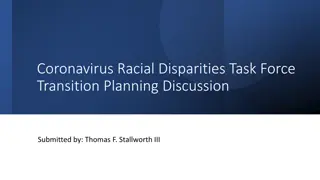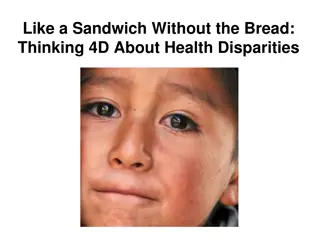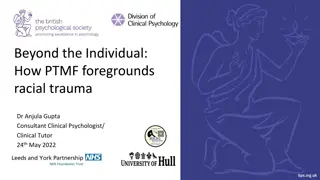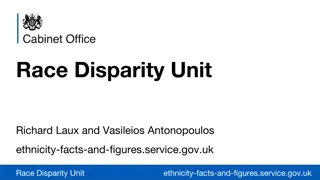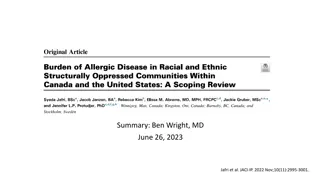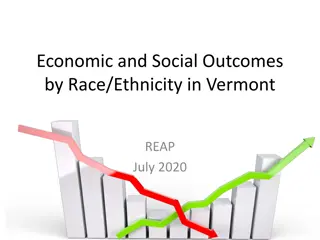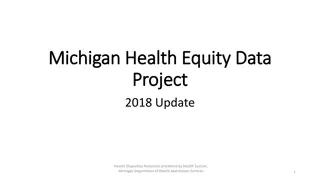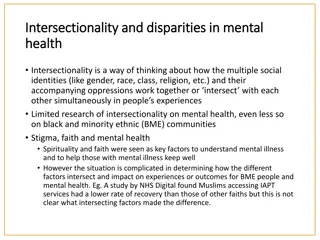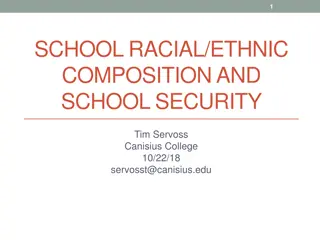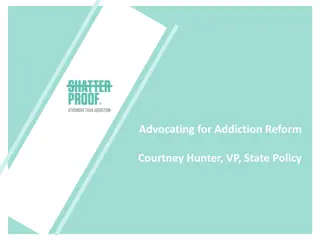Addressing Racial/Ethnic Disparities in Addiction Research
Research by Dr. LaTrice Montgomery and colleagues highlights the racial/ethnic disparities in addiction prevalence, treatment outcomes, and social impact. Studies show differences in opioid overdose deaths among adults, economic burdens of health inequities, and race moderation effects in clinical trials. Understanding and addressing these disparities are crucial for advancing health equity in addiction research.
Download Presentation

Please find below an Image/Link to download the presentation.
The content on the website is provided AS IS for your information and personal use only. It may not be sold, licensed, or shared on other websites without obtaining consent from the author.If you encounter any issues during the download, it is possible that the publisher has removed the file from their server.
You are allowed to download the files provided on this website for personal or commercial use, subject to the condition that they are used lawfully. All files are the property of their respective owners.
The content on the website is provided AS IS for your information and personal use only. It may not be sold, licensed, or shared on other websites without obtaining consent from the author.
E N D
Presentation Transcript
Advancing Health Equity: Advancing Health Equity: Conducting Addiction Research Conducting Addiction Research with Racial/Ethnic Minoritized with Racial/Ethnic Minoritized Populations Populations LaTrice Montgomery, Ph.D. Research Associate Professor Licensed Clinical Psychologist Center for Addiction Research Department of Psychiatry and Behavioral Neuroscience University of Cincinnati College of Medicine May 19, 2023
Racial/Ethnic Health Disparities in Addiction Racial/Ethnic Health Disparities in Addiction Racial/ethnic differences have been found in the prevalence, prevention, treatment and social impact of addiction Lippold, K. M., Jones, C. M., Olsen, E. O., & Giroir, B. P. (2019). Racial/Ethnic and Age Group Differences in Opioid and Synthetic Opioid-Involved Overdose Deaths Among Adults Aged 18 Years in Metropolitan Areas - United States, 2015-2017.MMWR. Morbidity and mortality weekly report,68(43), 967 973. https://doi.org/10.15585/mmwr.mm6843a3
LaVeist, T. A., Prez-Stable, E. J., Richard, P., Anderson, A., Isaac, L. A., Santiago, R., Okoh, C., Breen, N., Farhat, T., Assenov, A., & Gaskin, D. J. (2023). The Economic Burden of Racial, Ethnic, and Educational Health Inequities in the US. JAMA, 329(19), 1682 1692. https://doi.org/10.1001/jama.2023.5965 LaVeist, T. A., P rez-Stable, E. J., Richard, P., Anderson, A., Isaac, L. A., Santiago, R., Okoh, C., Breen, N., Farhat, T., Assenov, A., & Gaskin, D. J. (2023). The Economic Burden of Racial, Ethnic, and Educational Health Inequities in the US. JAMA, 329(19), 1682 1692. https://doi.org/10.1001/jama.2023.5965
LaVeist, T. A., Prez-Stable, E. J., Richard, P., Anderson, A., Isaac, L. A., Santiago, R., Okoh, C., Breen, N., Farhat, T., Assenov, A., & Gaskin, D. J. (2023). The Economic Burden of Racial, Ethnic, and Educational Health Inequities in the US. JAMA, 329(19), 1682 1692. https://doi.org/10.1001/jama.2023.5965
Montgomery, L., Petry, N. M., & Carroll, K. M. (2012). Moderating effects of race in clinical trial participation and outcomes among marijuana-dependent young adults. Drug and alcohol dependence,126(3), 333 339. https://doi.org/10.1016/j.drugalcdep.2012.05.033
Montgomery et al. Page 14 $watermark-text Figure 1. Average percentage of marijuana-negative urine specimens by racial and treatment group. (1) MET/CBT + CM = Motivational Enhancement Therapy/Cognitive-Behavioral Therapy + Contingency Management, (2) DC + CM = Drug Counseling + Contingency Management, (3) MET/CBT/no CM = Motivational Enhancement Therapy/Cognitive-Behavioral Therapy without Contingency Management, (4) DC/no CM = Drug Counseling without Contingency Management. Standard deviations for African Americans and Whites, respectively: (1) .33, . 45, (2) .35, .51, (3) .45, .43, (4) .39, .42 $watermark-text Montgomery, L., Petry, N. M., & Carroll, K. M. (2012). Moderating effects of race in clinical trial participation and outcomes among marijuana- dependent young adults. Drug and alcohol dependence, 126(3), 333 339. https://doi.org/10.1016/j.drugal cdep.2012.05.033 $watermark-text Drug Alcohol Depend. Author manuscript; available in PMC 2013 December 01.
Montgomery et al. Page 15 $watermark-text $watermark-text Figure 2. Average maximum number of days of continuous abstinence by racial and treatment group. (1) MET/CBT + CM = Motivational Enhancement Therapy/Cognitive-Behavioral Therapy + Contingency Management, (2) DC + CM = Drug Counseling + Contingency Management, (3) MET/CBT/no CM = Motivational Enhancement Therapy/Cognitive-Behavioral Therapy without Contingency Management, (4) DC/no CM = Drug Counseling without Contingency Management. Standard deviations for African Americans and Whites, respectively: (1) 19.65, 23.54, (2) 20.59, 23.58, (3) 22.18, 22.90, (4) 14.73, 22.09. $watermark-text Drug Alcohol Depend. Author manuscript; available in PMC 2013 December 01.
Montgomery, L., Carroll, K. M., & Petry, N. M. (2015). Initial abstinence status and contingency management treatment outcomes: does race matter?. Journal of consulting and clinical psychology, 83(3), 473 481. https://doi.org/10.1037/a0039021
Barriers to Research Participation among Barriers to Research Participation among Racial/Ethnic Minoritized Populations Racial/Ethnic Minoritized Populations Mistrust Time and financial constraints Fear of unintended outcomes Limited access to information/education about the study Stigma about research participation Fear of discrimination related to healthcare coverage Fear of deportation and immigration status being affected Transportation Religious beliefs Lack of social support, childcare Low SES Language barriers Provider biases Mental health and substance use George, S., Duran, N., & Norris, K. (2014). A systematic review of barriers and facilitators to minority research participation among African Americans, Latinos, Asian Americans, and Pacific Islanders. American journal of public health, 104(2), e16 e31. https://doi.org/10.2105/AJPH.2013.301706 Ford, J. G., Howerton, M. W., Lai, G. Y., Gary, T. L., Bolen, S., Gibbons, M. C., Tilburt, J., Baffi, C., Tanpitukpongse, T. P., Wilson, R. F., Powe, N. R., & Bass, E. B. (2008). Barriers to recruiting underrepresented populations to cancer clinical trials: a systematic review. Cancer, 112(2), 228 242. https://doi.org/10.1002/cncr.23157
NIH Public Access Author Manuscript Am J Drug Alcohol Abuse. Author manuscript; available in PMC 2012 September 18. Published in final edited form as: Am J Drug Alcohol Abuse. 2011 September ; 37(5): 324 332. doi:10.3109/00952990.2011.596973. NIH-PA Author Manuscript Conducting Research with Racial/Ethnic Minorities: Methodological Lessons from the NIDA Clinical Trials Network A. Kathleen Burlew, Ph.D., Jerren C. Weekes, M.A., La Trice Montgomery, M.A., Daniel J. Feaster, Ph.D., Michael S. Robbins, Ph.D., Carmen L. Rosa, M.S., Lesia M. Ruglass, Ph.D., Kamilla L. Venner, Ph.D., and Li-Tzy Wu, Sc.D. Abstract BACKGROUND Multiple studies in the National Institute on Drug Abuse Clinical Trials Network (CTN) demonstrate strategies for conducting effective substance abuse treatment research with racial/ethnic minorities (REMs). OBJECTIVES The objectives of this article are to describe lessons learned within the CTN to (1) enhance recruitment, retention, and other outcomes; (2) assess measurement equivalence; and (3) use data analytic plans that yield more information. NIH-PA Author Manuscript METHOD This article includes background information and examples from multiple CTN studies on inclusion, measurement, and data analysis. RESULTS AND CONCLUSIONS Seven recommendations are included for conducting more effective research on REMs. Research has revealed racial/ethnic differences in the prevalence of substance use (1), the relation of acculturation to substance use (2), legal and health consequences of substance use (3) and the likelihood of participating in and completing substance abuse treatment (4, 5). Therefore, research findings derived from predominantly White substance-using samples may not be generalizable to specific Racial/Ethnic Minorities (REMs). Instead, more focused research on REMs is required to obtain information to reduce and ultimately eliminate racial/ethnic disparities. In this paper, we share lessons from studies conducted within the Clinical Trials Network (CTN) of the National Institute of Drug Abuse (NIDA) about designing and conducting research to maximize the information available on Racial/ Ethnic differences. NIH-PA Author Manuscript The NIH Guidelines on the Inclusion of Women and Minorities require both the inclusion of REMs in Phase III clinical trials and valid analysis to detect differences in intervention effects (6). In addition, the Strategic Plan on Health Disparities Research of the National Institute on Drug Abuse (NIDA) encourages research aimed at reducing disparities in treatment and health services research (7). Despite these initiatives, task force reports of the American Psychological Association (APA) both before (8) and after (9) the establishment of the NIH guidelines along with other reviews (2, 10, 11) conclude that the efficacy of evidence-based-treatments (EBTs) for REMs frequently goes unexamined. Moreover, few resources are available to researchers for translating the NIH policy into practice. The NIDA \CTN conducts randomized clinical trials to evaluate substance abuse treatment interventions with demonstrated efficacy in larger, effectiveness trials. The CTN studies constitute an ideal venue for conducting research on promising treatments for REMs. As of Kathleen Burlew, Department of Psychology, University of Cincinnati, 4130D Edwards Building One, PO Box 210376, Cincinnati, OH 45221-0376, USA. Fax: 513-556-4168. Kathy.burlew@uc.edu
CANNABIS CANNABIS
Cannabis Cannabis
Mantey, D. S., Onyinye, O. N., & Montgomery, L. (2021). Prevalence and correlates of daily blunt use among U.S. African American, Hispanic, and White adults from 2014 to 2018. Psychology of addictive behaviors : journal of the Society of Psychologists in Addictive Behaviors, 35(5), 514 522. https://doi.org/10.1037/adb0000702 Montgomery, L., & Mantey, D. (2018). Racial/Ethnic Differences in Prevalence and Correlates of Blunt Smoking among Adolescents. Journal of psychoactive drugs, 50(3), 195 205. https://doi.org/10.1080/02791072.2017.1401186
Schauer, G. L., & Peters, E. N. (2018). Correlates and trends in youth co-use of marijuana and tobacco in the United States, 2005-2014. Drug and alcohol dependence, 185, 238 244. https://doi.org/10.1016/j.drugalcdep.2017.12.007
Cannabis and Tobacco Co Cannabis and Tobacco Co- -Use Use Exacerbation of mental health symptoms (e.g., childhood diagnoses, depressive symptoms/diagnosis) Greater likelihood of cannabis use disorders More psychosocial problems (e.g., legal problems, decreased life satisfaction) Poorer cannabis cessation outcomes (e.g., slower rate of change in cannabis use than cannabis only smokers) Additional risks for toxicant exposure Elevated risk of respiratory distress and reduced lung functioning (Agrawal, Budney, & Lynskey, 2012; Peters, Budney, & Carroll, 2012; Ramo, Liu, & Prochaska, 2012; Taylor, Ferguson, Milne et al., 2002)
Twitter-Based Intervention for Black Young Adult Blunt Smokers Inclusion Criteria: -Between the ages of 18-29 -Self identify as African American or Black -Self-report daily or near daily blunt use in the past month -Ready to set a goal to reduce or quit blunt use -Active social media user
Qualitative Themes Qualitative Themes Participants preferred to refer to blunts as joints Participants described how the quality of cannabis impacts how blunts are made and smoked Participants discussed norms regarding when and how blunts are smoked in groups Montgomery, L., Plano Clark, V. L., Twitty, D., Budney, A. J., Prochaska, J. J., & Winhusen, T. (2022). Is it "loud" enough?: A qualitative investigation of blunt use among African American young adults. Journal of ethnicity in substance abuse, 21(2), 747 761. https://doi.org/10.1080/15332640.2020.1801548
Intervention Topics Intervention Topics Introduction Self-Awareness Reasons to Quit Encouragement Social Support Coping with Stress Education/Health Issues






